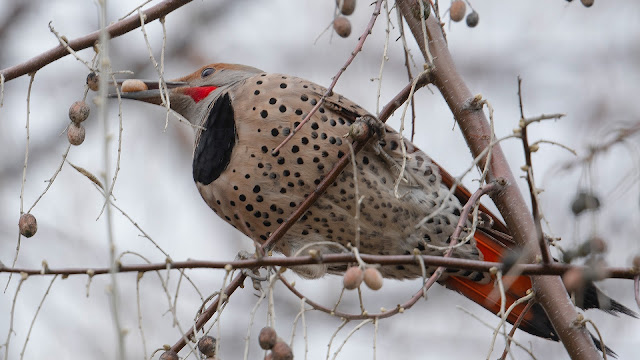Male northern flicker eating Russian olives - Did someone say martini?
Northern flickers are one of my favourite birds. They are common throughout much of Canada, are readily identified, and have beautiful feathering. Best of all, they are woodpeckers; in the spring their drumming can be heard throughout neighbourhoods as they stake out territory and search for mates.
Of course, not everyone is enthralled with this fact, especially if it is your house the birds happen to use as their percussion instrument. They seem to favour tin as the resulting din (tin din?) resounds for considerable distances.
Flickers are significant consumers of insects, especially ants, but such fodder is not readily available in winter. So they forage for seeds, dried berries, and in the case above, Russian olives.
I had not even heard of Russian olives until two days ago. Also called wild olives or silverberry, they are an imported plant from western Asia that produces many seeds, each one about the size of a grape. They are edible by mammals and birds alike and serve as an excellent source of energy in the winter.
The bad news about this plant is that it is invasive. Its berries are spread easily through the droppings of whatever feeds on them and they are resistant to drought. Russian olives will choke out other native plants and take over an area. I found the following quote from a Toronto Master Gardners website.
"Russian olive invades riparian systems where it outcompetes native vegetation, interferes with natural plant succession and nutrient cycling, taxes water reserves and reduces species diversity. It spreads vegetatively by sprouting from the root crown and sending up root suckers. Seed production is high and seeds remain viable for up to three years and germinate in a broad range of soil types. Seeds are dispersed by water as well as by birds and small mammals which eat the fruit."
Learning this is one of the reasons I enjoy photography as much as I do. I get outside, take photos, and come back to my computer area and get busy. Here (where I am now) I work on my pictures, write my blogs, and look up information. The other day I learned what Russian olives are, today I found out why they are invasive. Who knows what I will discover tomorrow.
Thanks for reading.
Eric Svendsen www.ericspix.com




Comments
Post a Comment